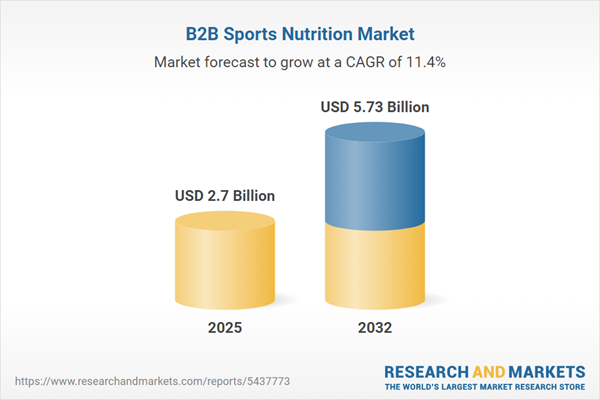Speak directly to the analyst to clarify any post sales queries you may have.
The B2B sports nutrition market is undergoing significant transformation as organizations seek to enhance compliance, strengthen supplier partnerships, and streamline procurement. This environment demands decision-makers leverage actionable intelligence to refine sourcing and maintain a competitive edge.
Market Snapshot: B2B Sports Nutrition Market Size and Growth
The global B2B sports nutrition market is advancing rapidly, projected to grow from USD 2.42 billion in 2024 to USD 2.70 billion in 2025, with an expected value of USD 5.73 billion by 2032. This growth is supported by a robust compound annual growth rate (CAGR) of 11.35%. Key drivers include increasing emphasis on enterprise wellness programs, deeper supplier collaboration, and continued innovation in sports nutrition products tailored for organizational efficiency and regulatory adherence. Companies are adopting advanced technologies and collaborative frameworks to navigate evolving procurement standards and enhance alignment with client needs in a dynamic market landscape.
B2B Sports Nutrition Market: Scope & Segmentation
- Product Types: Includes BCAAs, creatine, nitric oxide boosters, pre-workout blends, a diverse range of proteins such as whey, casein, plant-based, and collagen, as well as hydration, multivitamins, and weight management formulations. These segments cater to performance, recovery, and tailored enterprise wellness objectives.
- Distribution Channels: Products are delivered through pharmacies, specialty stores, proprietary brand-owned platforms, and multi-brand e-commerce to support customized fulfillment and procurement strategies.
- Form Factors: Options encompass bulk raw materials and finished goods available as powders, bars, capsules, tablets, and ready-to-drink items, with packaging adaptable for both large-scale and niche requirements.
- Applications: Utilized for endurance training, muscle recovery, corporate wellness initiatives, and structured weight management across diverse client segments, such as gyms, healthcare providers, retailers, and wholesalers.
- End Users: Primary buyers include wholesale distributors, gym operators, organizations with wellness programs, digital commerce firms, and B2B consultants managing supply chain operations.
- Regions: Participation spans the Americas, Europe, Middle East, Africa, and Asia-Pacific. Markets including China, India, Japan, Korea, Australia, and Southeast Asia contribute to elevated compliance standards and influence regional shifts.
- Technologies: Integration of digital fitness platforms, advanced analytics, improved traceability, and sustainable packaging solutions are accelerating regulatory compliance and procurement agility.
- Key Companies: Major suppliers offering specialized B2B sports nutrition solutions are Glanbia plc, Archer Daniels Midland Company, Cargill, Koninklijke DSM N.V., Kerry Group, DuPont de Nemours, IFF, Ingredion, Roquette Frères, and Tate & Lyle.
Key Takeaways for Senior Decision-Makers
- Flexible product portfolios position organizations to adapt strategies and supplier relationships as buying trends shift across global and local markets.
- Diversified offerings, including botanicals and adaptogens, enable targeting of multiple client groups and expansion into untapped sales channels for incremental growth.
- Transparent sourcing practices reduce compliance risks, ensuring operational resilience amid regulatory uncertainty in different regions.
- Enhanced digital procurement tools and data analytics give teams visibility to proactively respond to market changes or evolving competitive threats.
- Optimization of logistics and supply chain models supports seamless business continuity and rapid compliance with evolving local policies or supply fluctuations.
- Strategic, data-driven planning advances new product initiatives and quick market adaptation, aligning with dynamic client preferences and sector expectations.
Tariff Impact: Navigating Regulatory Change
Recent U.S. tariff changes have prompted B2B sports nutrition companies to reassess supply chains, emphasizing local sourcing and increased automation to manage exposure. Building domestic and regional capabilities helps sustain access to critical markets and strengthen customer relationships. These steps offer continuity and risk mitigation for organizations facing ongoing policy adjustments.
Methodology & Data Sources
This research combines insights from interviews with executives, thorough R&D and patent reviews, regulatory analysis, and leading industry literature. Each input is independently validated to deliver reliable intelligence to procurement-focused leaders in the B2B sports nutrition market.
Why This Report Matters
- Supports executives in designing growth strategies, identifying differentiators, and driving product development in sync with business objectives.
- Facilitates benchmarking with top competitors while monitoring key trends for forward-looking leadership and planning.
- Provides tools to effectively manage regulatory shifts, build resilient supply chains, and maintain strategic advantage during periods of change.
Conclusion
Senior leaders will gain the decision-ready insights necessary to optimize procurement, address evolving challenges, and secure long-term value as the B2B sports nutrition sector continues to develop.
Additional Product Information:
- Purchase of this report includes 1 year online access with quarterly updates.
- This report can be updated on request. Please contact our Customer Experience team using the Ask a Question widget on our website.
Table of Contents
3. Executive Summary
4. Market Overview
7. Cumulative Impact of Artificial Intelligence 2025
Companies Mentioned
The companies profiled in this B2B Sports Nutrition market report include:- Glanbia plc
- Archer Daniels Midland Company
- Cargill, Incorporated
- Koninklijke DSM N.V.
- Kerry Group plc
- DuPont de Nemours, Inc.
- International Flavors & Fragrances Inc.
- Ingredion Incorporated
- Roquette Frères S.A.
- Tate & Lyle PLC
Table Information
| Report Attribute | Details |
|---|---|
| No. of Pages | 189 |
| Published | October 2025 |
| Forecast Period | 2025 - 2032 |
| Estimated Market Value ( USD | $ 2.7 Billion |
| Forecasted Market Value ( USD | $ 5.73 Billion |
| Compound Annual Growth Rate | 11.3% |
| Regions Covered | Global |
| No. of Companies Mentioned | 11 |









